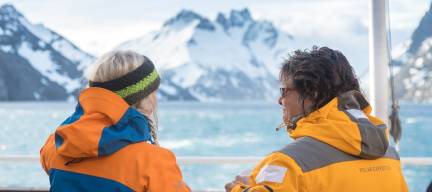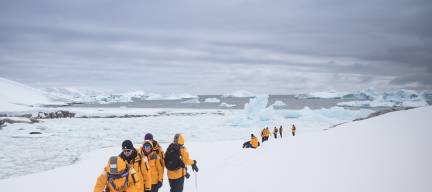Each spring, the skies above Svalbard come alive with a remarkable spectacle: the migration of barnacle geese. These elegant birds undertake one of the most extraordinary journeys in the natural world, flying thousands of kilometers from their wintering grounds in Scotland and the Netherlands to the remote Arctic Archipelago of Svalbard. For bird enthusiasts and wildlife photographers alike, witnessing this migration is an unforgettable experience.
Svalbard’s high Arctic environment offers a unique combination of accessibility and pristine wilderness, making it a prime destination for observing Arctic birds in their natural habitat. Travelers from the USA, Canada, and Australia are increasingly drawn to birdwatching trips that coincide with the geese’s arrival. On Arctic expeditions, participants can witness the flocks navigating rugged fjords, nesting in cliffside colonies, and interacting with other elements of Arctic wildlife.

The Journey of Barnacle Geese
Barnacle geese are remarkable for their endurance and precision. Each year, they leave temperate regions in early spring, traveling non-stop across the North Sea and over the Greenland icecap. Their migration is guided by an incredible internal compass and visual cues, enabling them to arrive in Svalbard just in time to breed and raise their young in the short Arctic summer.
Observing these birds in flight is not only awe-inspiring but also offers an opportunity to study natural behavior. For wildlife photography, capturing barnacle geese in formation, gliding over icy fjords, or landing near nesting grounds can result in striking images that tell a story of resilience and adaptation. The Spitsbergen Circumnavigation: Rite of Passage is one expedition designed for travelers eager to combine Arctic exploration with close encounters of these incredible birds.

Why Svalbard is Ideal for Birdwatching
Svalbard’s geography and climate make it a sanctuary for Arctic species. During the summer months, the long daylight hours allow extended observation opportunities. The combination of steep cliffs, sheltered bays, and wide plains provides ideal nesting and feeding grounds for barnacle geese and other Arctic birds such as puffins, guillemots, and eiders.
Guided Arctic expeditions prioritize minimizing disturbance while maximizing sightings. Zodiac rides and guided hikes allow visitors to approach colonies safely, ensuring that birds remain undisturbed while travelers capture memorable images. These excursions also enhance knowledge about the local ecosystem, providing insights into predator-prey interactions, seasonal feeding patterns, and the role of climate in migratory behavior.

Combining Birdwatching with Arctic Wildlife Encounters
While barnacle geese often take center stage, Svalbard offers opportunities to observe a diverse array of Arctic wildlife. Polar bears, reindeer, Arctic foxes, and seals coexist in the same environment, providing dynamic contexts for nature photography. Many birdwatchers combine their interest in wildlife photography with broader exploration, creating a richer understanding of the Arctic ecosystem.
Taking a camera along on these journeys can transform a simple birdwatching trip into a visual narrative. Photographers often find that the best compositions include elements like icy fjords, dramatic skies, or interactions between species. Even small behavioral cues, such as geese tending to their young, can elevate an image from a simple shot to a compelling story.

Seasonal Considerations for Arctic Birdwatching
Timing is crucial for observing barnacle geese. Peak arrival in Svalbard generally occurs between late April and early May, with nesting and chick-rearing happening shortly after. Travelers planning a birdwatching-focused trip should consider seasonal factors, such as weather conditions, daylight hours, and accessibility of remote areas.
For those looking to extend their Arctic experience, the Svalbard Explorer: Best of High Arctic Norway combines birdwatching with broader exploration. Guests can explore glacial landscapes, capture images of Arctic wildlife, and enjoy immersive experiences that go beyond typical sightseeing. More details on Arctic journeys are available at Quark Expeditions, which specializes in safe, guided trips to Svalbard and other Arctic destinations.

Tips for Capturing the Perfect Shot
- Use Telephoto Lenses: Barnacle geese are best photographed from a distance to avoid disturbing them.
- Consider Lighting: Early mornings and late evenings provide soft light that enhances feathers’ textures and colors.
- Include Context: Show the surrounding landscape to convey scale and environment.
- Be Patient: Arctic wildlife behaves unpredictably, and waiting for the right moment often yields the best images.
- Respect Nature: Maintain safe distances and follow expert guidance to protect nesting sites and local wildlife.
Final Thoughts
The migration of barnacle geese is more than just a natural phenomenon; it is a story of endurance, survival, and the beauty of the Arctic. Svalbard’s combination of accessibility, pristine landscapes, and rich Arctic wildlife makes it a premier destination for birdwatchers, photographers, and nature enthusiasts alike. By joining guided Arctic expeditions, travelers can witness these birds up close, learn from experts, and capture stunning images that tell a story far beyond the lens.









